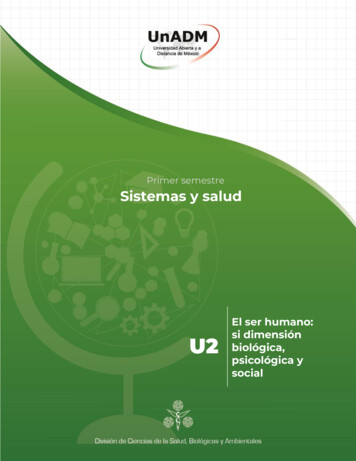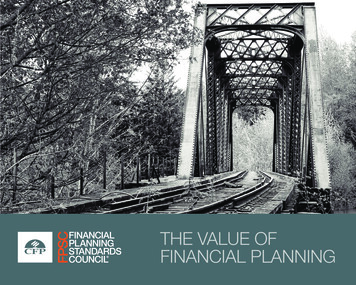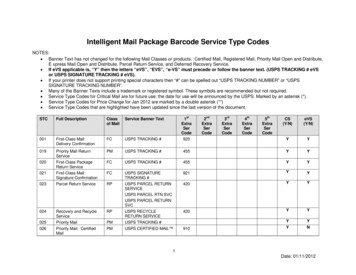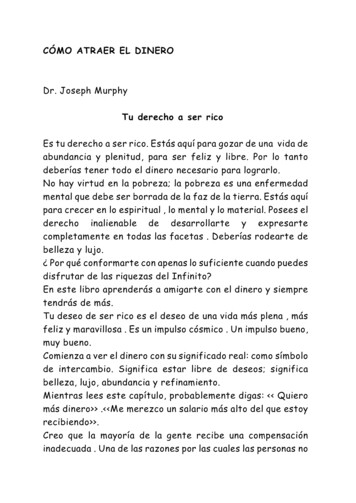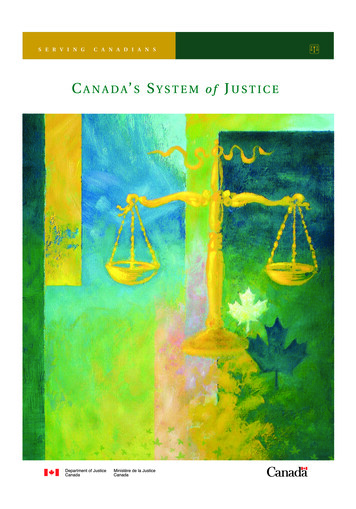
Transcription
S E R V I N GC A N A D I A N SC A N A D A’ S S Y S T E M o f J U S T I C E
Information contained in this publication or product may be reproduced,in part or in whole, and by any means, for personal or public non-commercialpurposes, without charge or further permission, unless otherwise specified.You are asked to: exercise due diligence in ensuring the accuracy of the materials reproduced; indicate both the complete title of the materials reproduced, as well as theauthor organization; and indicate that the reproduction is a copy of an official work that is publishedby the Government of Canada and that the reproduction has not beenproduced in affiliation with or with the endorsement of the Governmentof Canada.Commercial reproduction and distribution is prohibited except with writtenpermission from the Department of Justice Canada. For more information,please contact the Department of Justice Canada at: www.justice.gc.ca. Her Majesty the Queen in Right of Canada,represented by the Minister of Justice and Attorney General of Canada, 2015ISBN 978-1-100-25574-3Cat. No J2-32/2015E-PDF
CA N A DA’ S SY ST E MOF JUSTICE
Note to reader: This booklet provides general information aboutCanada’s justice system. It is not intended as legal advice. If you havea problem, you should consult a lawyer or other qualified professional.
CONTENTSWhat is the Law?. . . . . . . . . . . . . . . . . . . . . . . . . . . . . . . . . . . . . . . . . . . . . . . . . . . . . . . . . . . . . . . . 1Why We Need Laws. . . . . . . . . . . . . . . . . . . . . . . . . . . . . . . . . . . . . . . . . . . . . . . . . . . . . . . . . . . . . . 1What Other Goals Do Laws Achieve?. . . . . . . . . . . . . . . . . . . . . . . . . . . . . . . . . . . . . . . . . . . 2Public Law and Private Law. . . . . . . . . . . . . . . . . . . . . . . . . . . . . . . . . . . . . . . . . . . . . . . . . . . . . . 2Where Our Legal System Comes From. . . . . . . . . . . . . . . . . . . . . . . . . . . . . . . . . . . . . . 4The Common-Law Tradition. . . . . . . . . . . . . . . . . . . . . . . . . . . . . . . . . . . . . . . . . . . . . . . . . . . . .The Civil-Law Tradition. . . . . . . . . . . . . . . . . . . . . . . . . . . . . . . . . . . . . . . . . . . . . . . . . . . . . . . . . .Aboriginal and Treaty Rights. . . . . . . . . . . . . . . . . . . . . . . . . . . . . . . . . . . . . . . . . . . . . . . . . . . . .How Parliament Makes Laws. . . . . . . . . . . . . . . . . . . . . . . . . . . . . . . . . . . . . . . . . . . . . . . . . . . . .What Are Regulations?. . . . . . . . . . . . . . . . . . . . . . . . . . . . . . . . . . . . . . . . . . . . . . . . . . . . . . . . . . . .44456Keeping the Laws Up to Date. . . . . . . . . . . . . . . . . . . . . . . . . . . . . . . . . . . . . . . . . . . . . . . . . 7Law Reform. . . . . . . . . . . . . . . . . . . . . . . . . . . . . . . . . . . . . . . . . . . . . . . . . . . . . . . . . . . . . . . . . . . . . . . 7Alternative Approaches to Laws. . . . . . . . . . . . . . . . . . . . . . . . . . . . . . . . . . . . . . . . . . . . . . . . . . 7Changing Laws. . . . . . . . . . . . . . . . . . . . . . . . . . . . . . . . . . . . . . . . . . . . . . . . . . . . . . . . . . . . . . . . . . . . 8The Canadian Constitution. . . . . . . . . . . . . . . . . . . . . . . . . . . . . . . . . . . . . . . . . . . . . . . . . . . 9What Does Our Constitution Say?. . . . . . . . . . . . . . . . . . . . . . . . . . . . . . . . . . . . . . . . . . . . . . . 9What is a Federal System?. . . . . . . . . . . . . . . . . . . . . . . . . . . . . . . . . . . . . . . . . . . . . . . . . . . . . . . 10Rights and Freedoms in Canada. . . . . . . . . . . . . . . . . . . . . . . . . . . . . . . . . . . . . . . . . . . . 13What Does the Canadian Charter of Rights and Freedoms Say?. . . . . . . . . . . . . . . . 13What Rights Does the Charter Protect?. . . . . . . . . . . . . . . . . . . . . . . . . . . . . . . . . . . . . . . . 14–.Fundamental freedoms. . . . . . . . . . . . . . . . . . . . . . . . . . . . . . . . . . . . . . . . . . . . . . . . . . . . . 15–.Democratic rights. . . . . . . . . . . . . . . . . . . . . . . . . . . . . . . . . . . . . . . . . . . . . . . . . . . . . . . . . . 15–.Mobility rights. . . . . . . . . . . . . . . . . . . . . . . . . . . . . . . . . . . . . . . . . . . . . . . . . . . . . . . . . . . . . . 15–.Legal rights. . . . . . . . . . . . . . . . . . . . . . . . . . . . . . . . . . . . . . . . . . . . . . . . . . . . . . . . . . . . . . . . . . 16–.Equality rights. . . . . . . . . . . . . . . . . . . . . . . . . . . . . . . . . . . . . . . . . . . . . . . . . . . . . . . . . . . . . . 17–.Language rights. . . . . . . . . . . . . . . . . . . . . . . . . . . . . . . . . . . . . . . . . . . . . . . . . . . . . . . . . . . . . 18–.Minority-language educational rights. . . . . . . . . . . . . . . . . . . . . . . . . . . . . . . . . . . . . 19–.Aboriginal and treaty rights. . . . . . . . . . . . . . . . . . . . . . . . . . . . . . . . . . . . . . . . . . . . . . . . 19Other Rights. . . . . . . . . . . . . . . . . . . . . . . . . . . . . . . . . . . . . . . . . . . . . . . . . . . . . . . . . . . . . . . . . . . . . . 20i
CA N A DA’ S SY ST E M O F J U ST I C EHow the Courts are Organized. . . . . . . . . . . . . . . . . . . . . . . . . . . . . . . . . . . . . . . . . . . . . . 21What Do the Federal Courts Do?. . . . . . . . . . . . . . . . . . . . . . . . . . . . . . . . . . . . . . . . . . . . . . . 22Provincial and Territorial Level Courts. . . . . . . . . . . . . . . . . . . . . . . . . . . . . . . . . . . . . . . . . . 22Administrative Boards and Tribunals. . . . . . . . . . . . . . . . . . . . . . . . . . . . . . . . . . . . . . . . . . . . 23Civil and Criminal Cases. . . . . . . . . . . . . . . . . . . . . . . . . . . . . . . . . . . . . . . . . . . . . . . . . . . . . . 24How Do Civil Cases Work?. . . . . . . . . . . . . . . . . . . . . . . . . . . . . . . . . . . . . . . . . . . . . . . . . . . . . 24Pleading. . . . . . . . . . . . . . . . . . . . . . . . . . . . . . . . . . . . . . . . . . . . . . . . . . . . . . . . . . . . . . . . . . . . . . . . . . . 24Discovery. . . . . . . . . . . . . . . . . . . . . . . . . . . . . . . . . . . . . . . . . . . . . . . . . . . . . . . . . . . . . . . . . . . . . . . . . 24Trial. . . . . . . . . . . . . . . . . . . . . . . . . . . . . . . . . . . . . . . . . . . . . . . . . . . . . . . . . . . . . . . . . . . . . . . . . . . . . . . 24What Happens at a Civil Trial?. . . . . . . . . . . . . . . . . . . . . . . . . . . . . . . . . . . . . . . . . . . . . . . . . . 25How a Trial Ends. . . . . . . . . . . . . . . . . . . . . . . . . . . . . . . . . . . . . . . . . . . . . . . . . . . . . . . . . . . . . . . . . 25Remedies. . . . . . . . . . . . . . . . . . . . . . . . . . . . . . . . . . . . . . . . . . . . . . . . . . . . . . . . . . . . . . . . . . . . . . . . . . 26What Are Criminal Cases?. . . . . . . . . . . . . . . . . . . . . . . . . . . . . . . . . . . . . . . . . . . . . . . . . . . . . . . 26Summary Offences. . . . . . . . . . . . . . . . . . . . . . . . . . . . . . . . . . . . . . . . . . . . . . . . . . . . . . . . . . . . . . . 27Indictable Offences. . . . . . . . . . . . . . . . . . . . . . . . . . . . . . . . . . . . . . . . . . . . . . . . . . . . . . . . . . . . . . . 27What Happens in an Arrest?. . . . . . . . . . . . . . . . . . . . . . . . . . . . . . . . . . . . . . . . . . . . . . . . . . . . . 27What Happens in Custody?. . . . . . . . . . . . . . . . . . . . . . . . . . . . . . . . . . . . . . . . . . . . . . . . . . . . . 27What Happens in a Criminal Trial?. . . . . . . . . . . . . . . . . . . . . . . . . . . . . . . . . . . . . . . . . . . . . 28Decisions in Criminal Cases. . . . . . . . . . . . . . . . . . . . . . . . . . . . . . . . . . . . . . . . . . . . . . . . . . . . . 28Can You Appeal a Decision?. . . . . . . . . . . . . . . . . . . . . . . . . . . . . . . . . . . . . . . . . . . . . . . . . . . . . 29Victims of Crime. . . . . . . . . . . . . . . . . . . . . . . . . . . . . . . . . . . . . . . . . . . . . . . . . . . . . . . . . . . . . . . 30Restorative Justice. . . . . . . . . . . . . . . . . . . . . . . . . . . . . . . . . . . . . . . . . . . . . . . . . . . . . . . . . . . . 31Youth Justice. . . . . . . . . . . . . . . . . . . . . . . . . . . . . . . . . . . . . . . . . . . . . . . . . . . . . . . . . . . . . . . . . . . 32The Role of the Public. . . . . . . . . . . . . . . . . . . . . . . . . . . . . . . . . . . . . . . . . . . . . . . . . . . . . . . . . 34Jury Duty. . . . . . . . . . . . . . . . . . . . . . . . . . . . . . . . . . . . . . . . . . . . . . . . . . . . . . . . . . . . . . . . . . . . . . . . . 34Testifying in Court. . . . . . . . . . . . . . . . . . . . . . . . . . . . . . . . . . . . . . . . . . . . . . . . . . . . . . . . . . . . . . . 35Know the Law. . . . . . . . . . . . . . . . . . . . . . . . . . . . . . . . . . . . . . . . . . . . . . . . . . . . . . . . . . . . . . . . . . . . 35Who Gets Legal Aid?. . . . . . . . . . . . . . . . . . . . . . . . . . . . . . . . . . . . . . . . . . . . . . . . . . . . . . . . . . . . 36Definitions. . . . . . . . . . . . . . . . . . . . . . . . . . . . . . . . . . . . . . . . . . . . . . . . . . . . . . . . . . . . . . . . . . . . . . 36ii
WHAT IS THE LAW?The law affects nearly every aspectof our lives every day. We have lawsto deal with crimes like robberyand murder. And we have laws thatgovern activities like driving a car,getting a job, and getting married.Laws give us rules of conduct thatprotect everyone’s rights.The rule of law, freedom underthe law, democratic principles, andrespect for others form the foundations of Canada’s legal heritage.Every Canadian should understandthe law, and the ideas and principlesbehind it. This publication will helpreaders understand what the law is; where it comes from; what it is for; and how it operates.Laws also balance individual rightswith our obligations as membersof society. For example, when a lawgives a person a legal right to drive,it also makes it a duty for a driver toknow how to drive and to follow therules of the road.Why We Need LawsLaws are rules made by governmentthat forbid certain actions and areenforced by the courts. Laws apply toeveryone equally. If youbreak a law, you mayhave to pay a fine, payThe law providesfor the damage you havea way to resolvedone, or go to jail.disputesImagine the chaos –and the danger –peacefully.if there were no laws.The strongest peoplewould be in control andpeople would live in fear. Driverscould choose which side of the streetto drive on and no one could stopthem. Imagine trying to buy and sellgoods if no one had to keep promises.Or trying to hold onto your personalproperty or even to keep yourself safeif there were no laws against robberyor assault.Even in a well-ordered society, peopledisagree, and conflicts arise. The lawprovides a way to resolve disputespeacefully. If two people claim thesame piece of property, rather thanfight they turn to the law. The courts1
CA N A DA’ S SY ST E M O F J U ST I C Ecan decide who the real owner is andhow to protect the owner’s rights.Laws help to ensure a safe andpeaceful society. The Canadian legalsystem respects individual rights andensures that our society is orderly.It applies the same law to everybody.This includes the police, governmentsand public officials. All of them mustcarry out their duties according tothe law.What Other Goals DoLaws Achieve?In Canada, laws also carry out socialpolicies. Laws allow systems to be putin place for governmentsto provide, for example,Our laws alsorecognize andprotect basicindividual rightsand freedoms,such as libertyand equality.2 benefits when workersare injured on the job; insurance whenworkers areunemployed; health care; and loans to students.Our laws also recognizeand protect basicindividual rights andfreedoms, such as libertyand equality. This helps preventstronger groups and individuals fromtaking unfair advantage of weakergroups or people.Public Law and Private LawLaws can be divided into public lawand private law.Public law sets the rules for therelationship between the individualand society. If someone breaks acriminal law, it is seen as a wrongagainst society. It includes criminal law, which deals withcrimes and their punishments; constitutional law, which definesthe relationship between variousbranches of government, as wellas between federal and provincialgovernments; it also limits theexercise of governmental powerover individuals through theprotection of human rights andfundamental freedoms; administrative law, which dealswith the actions and operationsof government.If someone runs away from a storewith unpaid goods, that’s theft.It violates public law because it affects
CA N A DA’ S SY ST E M O F J U ST I C Eother people. If you back up yourcar into somebody’s fence, you couldbe violating their right to enjoytheir property. That falls underprivate law.Private law sets the rules betweenindividuals. It is also called civil law.Private law settles disputes amonggroups of people and compensatesvictims, as in the example of thefence. A civil case is an action thatsettles private disputes.3
WHERE OUR LEGAL SYSTEM COMES FROMDID YOU KNOW?Canada’s legal system is based on the English and French systems.Explorers and colonists brought these systems to Canada in the17th and 18th centuries. After the Battle of Quebec in 1759, the countryfell under English common law, except for Quebec, which followscivil law.Canada’s legal system is based ona combination of common lawand civil law.The Common-Law TraditionThe common law is law that is notwritten down as legislation. Commonlaw evolved into a system of rulesbased on precedent. This is a rule thatguides judges in making later decisions in similar cases. The commonlaw cannot be found in any code orbody of legislation, butonly in past decisions.At the same time, it isQuebec is the onlyflexible. It adapts tochanging circumstancprovince with aes because judges cancivil code.announce new legaldoctrines or changeold ones.4The Civil-Law TraditionCivil codes contain a comprehensivestatement of rules. Many are framedas broad, general principles to dealwith any dispute that may arise.Unlike common-law courts, courts ina civil-law system first look to a civilcode, then refer to previous decisionsto see if they’re consistent.Quebec is the only province witha civil code, which is based on theFrench Code Napoléon (NapoleonicCode). The rest of Canada uses thecommon law. The Criminal Code isalso considered a code, and it is usedthroughout Canada.Aboriginal and Treaty RightsAboriginal rights refer to Aboriginalpeoples’ historical occupancy and useof the land. Treaty rights are rights
CA N A DA’ S SY ST E M O F J U ST I C Eset out in treaties entered into bythe Crown and a particular group ofAboriginal people. The Constitutionrecognizes and protects Aboriginalrights and treaty rights.How Parliament Makes LawsDemocratic countries have a legislature or parliament, with the power toThe Two Meaningsof Civil LawThe term “civil law” is used to meantwo quite different things, whichcan be a little confusing at first forpeople trying to understand thejustice system. Sometimes the termis used in contrast to “common law”to refer to the legal system that isbased on a civil code, such as theJustinian Code or the Civil Codeof Quebec. In its other sense, civillaw refers to matters of privatelaw as opposed to public law, andparticularly criminal law, which isconcerned with harm to societyat large. It is usually clear from thecontext which type of civil lawis intended.make new laws or change old ones.Canada is a federation – a union ofseveral provinces and territories witha central government. So it has botha federal parliament in Ottawa tomake laws for all of Canada and alegislature in each of the ten provincesand three territories that deals withlaws in their areas. Laws enacted ateither level are calledstatutes, legislation, oracts. When ParliamentThe Constitutionor a provincial or terrirecognizes andtorial legislature passesa statute, it takes theprotects Aboriginalplace of common law orprecedents dealing withrights and treatythe same subject.rights.Making laws this way canbe complicated. Let’s usean example to explainhow it works. Suppose the federalgovernment wanted to create a lawthat would help control pollution.1. Government ministers or seniorpublic servants examine theproblem carefully and suggestways in which, under federaljurisdiction, a law could dealwith pollution.2. They would draft the proposed law.5
CA N A DA’ S SY ST E M O F J U ST I C E3. The law has to be approved bythe cabinet, which is traditionallymade up of members of Parliamentchosen by the prime minister.4. This version is then presented toParliament as a bill to be studiedand debated by members.5. The bill becomes law if it isapproved by a majority in boththe House of Commons and theSenate. It also needs to be assented to by the Governor General inthe name of the Queen. All lawsneed royal assent.Every province uses a similar process.The Lieutenant Governor of eachprovince gives royal assent for lawspassed by provincial legislatures.Judges develop common law byreferring to and setting precedents.They also interpret and apply statutes.6What Are Regulations?Because our society is so complex,more laws are being enacted todaythan ever before. If our lawmakershad to deal with all the details of allthe laws, the task would be nearlyimpossible. To solve this problem,Parliament and provincial and territoriallegislatures often pass laws to givedepartments or other governmentorganizations the authority to makespecific laws called regulations.Regulations carry out the purposesof the general laws or expand onthem. They have the force of a law.For example, there are regulationsthat keep our food safe or outlinewhat kind of storage tank to use foroil products.
KEEPING THE LAWS UP TO DATELaw ReformEvery day, we hear about social issues,medical developments, and new typesof technology. All of these raise moraland legal questions. These kinds ofchanges mean we need to constantlyreform our laws so we can make surethat our system of law and justicemeets the challenges of our society.As our society grows and develops,it cannot rely entirely on tradition.Sometimes new laws are needed orold laws need to be changed.As people change the way they liveand work, some laws may becomeobsolete. Or new situations may arisethat no existing law deals with.For example, old laws against theftdid not foresee identity theft or onlineharassment. The same technology thatenables one person to find information about another also makes itpossible to steal information thatwas meant to be private.Alternative Approaches to LawsWe may even need to change thesystem of law and justice itself.In our court system, it can take yearsto settle disputes. People can settledisputes by using less formalmethods. Some informal mediationmethods, such as alternative disputeresolution and landlord-tenantdisputes, are already being used.Aboriginal customs and traditionshave also contributed to new ways ofdealing with people, such as healingand sentencing circles, communityjustice, and restorativejustice.The Aboriginal JusticeStrategy (AJS) is a wayof diverting low-risknon-violent offendersfrom mainstream justiceto restorative justice.As a result, offendersdon’t get a criminalrecord, they can insteadmake amends to theircommunity, and fundsand resources are freedup to deal with moreserious offences.We need toconstantly reformour laws so we canmake sure that oursystem of law andjustice meets thechallenges ofour society.The goals of the AJS are to give Aboriginal people a greaterrole in administering justice intheir communities; to help decrease the rates of victimization, crime, and imprisonmentamong Aboriginal people; to provide better and more timelyinformation about community7
CA N A DA’ S SY ST E M O F J U ST I C Ejustice programs funded by theAJS; and to reflect and include Aboriginalvalues within the justice system.Changing LawsGovernment legal experts areconstantly examining our laws andlooking for ways to improve them.Law reform committees also reviewlaws and recommend changes.Lawyers bring questions of law tocourt to create change. Social actiongroups seek changes to laws thatthey consider unfair to members ofCanadian society. Industry groups8and other stakeholders meet withgovernment decision makers in aneffort to present their opinions on thedirection of public policy. Legislatorsin the federal, provincial, andterritorial governments respond byintroducing new laws or changingold ones.Ultimately, though, it is the peopleof Canada who elect the lawmakers.We as Canadians need to decidewhat we want from the law and thenmake sure it reflects those wishes.Everyone has the right to worktoward changing the law.
THE CANADIAN CONSTITUTIONDID YOU KNOW?Canada was created by an act of the Parliament of the United Kingdomcalled the British North America Act, 1867 (now known as the Constitution Act,1867), uniting the British colonies of the United Province of Canada, NovaScotia, and New Brunswick.A constitution provides the fundamentalrules and principles that governa country. It creates many of the institutions and branches of government,and defines their powers.The Constitution of Canada includesthe Constitution Act, 1867, and theConstitution Act, 1982. It is thesupreme law of Canada. It reaffirmsCanada’s dual legal system andalso includes Aboriginal rights andtreaty rights.What Does Our Constitution Say?The Constitution sets out the basicprinciples of democratic governmentin Canada when it defines the powersof the three branches of government: the executive the legislative the judiciaryThe Queen has the executive powerin Canada, but in our democraticsociety the Queen’s powers areexercised by constitutional conventionon the advice of Ministers who enjoythe confidence of the House ofCommons. Together, the PrimeMinister and other Ministers formthe cabinet, which is responsible toParliament for government business.Ministers are also responsible forgovernment departments, such asthe Department of Finance and theDepartment of Justice. When we say“the government,” we are usuallyreferring to the executive branch.Parliament is the legislative branchof the federal government. Parliamentconsists of the Queen (who isusually represented by the GovernorGeneral), the Senate and the Houseof Commons. Bills are debated andpassed by the Senate and the Houseof Commons. The Governor Generalmust also give royal assent to a bill9
CA N A DA’ S SY ST E M O F J U ST I C EDID YOU KNOW?The Constitution was “patriated” from the United Kingdom in 1982.When Canada was created, it was a self-governing British colony. The BritishNorth America Act, 1867 codified many constitutional rules for Canada,but major changes to the Constitution could only be made by the UnitedKingdom Parliament. In 1982, the Charter was enacted as part of Canada’sConstitution along with a set of procedures allowing the Constitution to beamended in Canada.in order for it to become a law.By constitutional convention, royalassent is always given to bills passedby the Senate and the House ofCommons.Our Constitution also includesprovisions relating to the judicialbranch of government, composed ofjudges. The judiciary must interpretand apply the law and the Constitution, and give impartialjudgments in all cases,whether they involveParliament is thepublic law, such as acriminal case, or privatelegislative branchlaw, such as a disputeover a contract.of the federalgovernment.10The Constitution onlyprovides for federallyappointed judges.Provincial judges are appointed underprovincial laws.What is a Federal System?The Parliament of Canada and theprovincial and territorial legislaturesboth have the authority or jurisdiction to make laws. Parliament canmake laws for all of Canada, butonly about matters the Constitutionassigns to it. A provincial orterritorial legislature can onlymake laws about matters withinthe province’s borders.The federal Parliament deals mainlywith issues that concern Canada asa whole: trade between provinces,national defence, criminal law,money, patents, and the postalservice. It is also responsible for
CA N A DA’ S SY ST E M O F J U ST I C Ethe three territories: Yukon, theNorthwest Territories, and Nunavut.Federal law allows territories to electcouncils with powers like those ofthe provincial legislatures.The provinces have the authority tomake laws about education, property,civil rights, the administration ofjustice, hospitals, municipalities, andother local or private matters withinthe provinces.There are also local or municipalgovernments. They are created underprovincial laws and can make bylawsthat regulate a variety of local matters:The Department of JusticeThe Minister of Justice is responsible for the Department of Justice,which provides legal services suchas drafting laws and providinglegal advice to the governmentand its departments. The department also develops criminal lawand public law, as well as policiesand programs for victims, families,children and youth criminal justice.The Minister of Justice is also theAttorney General or chief lawofficer of Canada.zoning, smoking,pesticide use, parking,business regulations, andconstruction permits.Aboriginal peoples inCanada have differenttypes of government.For example, FirstNations can have a rangeof governmental powersover reserve lands underthe federal Indian Act.Other Aboriginalgovernments, such asself-governments,exercise these powers asa result of agreementsthey have negotiatedwith the federal andprovincial or territorialgovernments.It was only withthe CanadianCharter of Rightsand Freedomsthat humanrights in Canadawere protectedin the writtenConstitution.The Constitution Act includes protection for the rights of the Aboriginalpeoples (Indian, Inuit, and Métis)of Canada. Section 35 of theConstitution Act recognizes andaffirms Aboriginal rights, which arerights related to the historical occupancy and use of the land by Aboriginalpeoples. This is to help Aboriginalpeoples preserve their customs andtraditions for future generations,as continuing cultural practices.11
CA N A DA’ S SY ST E M O F J U ST I C EDID YOU KNOW?The Constitution Act, 1867 authorized Parliament to establish a general courtof appeal for Canada, as well as any additional courts to better administerthe laws of Canada. It was under this authority that the Federal Courts, theTax Court, and the Supreme Court of Canada were established.Section 35 also recognizes and affirmstreaty rights, which are specificallyset out in agreements between theCrown and particular groups ofAboriginal people.BijuralismCanada is a bijural country – thatmeans it has both common and civillaw systems. Matters of private law inQuebec are governed by the civil law,while the common law applies in theother provinces. Federal bills andregulations must respect both typesof systems, and the legal conceptswithin these laws must be expressedin both English and French.12Other Federal SystemsAustralia and the United Statesalso have federal systems wherejurisdiction is divided betweenthe federal government and thevarious states. In contrast, theUnited Kingdom has a unitarysystem where there is only onelevel of government.
RIGHTS AND FREEDOMS IN CANADAIn Canada, the Constitution, as wellas federal, provincial and territoriallaws, protect our human rights andfundamental freedoms.The Canadian Bill of Rights, passedin 1960, was the first federal humanrights law in Canada. It guaranteesmany basic rights and freedoms,including the “right of the individualto life, liberty, security of the personand enjoyment of property” and theright not to be deprived of any ofthose rights except in accordancewith “due process,” meaning basicprocedural fairness.The Canadian Human Rights Act,passed in 1977, also protects humanrights in the federal public andprivate sectors (for example, banking,rail, telecommunications, interprovincial transportation),particularly the right to equalityand non-discrimination in the areasof employment, housing and theprovision of services.All provinces and territories alsohave human rights legislation whichprohibits discrimination in employment, housing and in providinggoods, services, and facilities to thepublic. Some provincial and territoriallaws protect a broader range of rightsand freedoms. But like any legislation,these laws can be repealed or changed,so their protection can be limited.It was only with the Canadian Charterof Rights and Freedoms that humanrights in Canada were protected inthe written Constitution.What Does the Canadian Charterof Rights and Freedoms Say?The Constitution says that theCharter takes priority over all otherlegislation in Canada because it ispart of the “supreme lawof Canada.” It applies toall government action,The interests ofmeaning to the provinciallegislatures and Parliasociety must alwaysment, and to everythingbe balanced againstdone under theirauthority. This meansthe interests ofthat governments musttake the Charter intoindividuals to seeaccount in developingall laws and policies. Itif limits onalso means that when anindividual goes to courtindividual rightsbecause he or shecan be justified.believes that Parliamentor a legislature or agovernment officialhas violated rights orfundamental freedoms guaranteedin the Charter, the court may declare13
CA N A DA’ S SY ST E M O F J U ST I C Ethe law invalid if it conflicts withthe Charter or provide any other“appropriate and just” remedy.However, section 1 of the Charter alsorecognizes that even in a democracy,rights and freedoms are not absolute.For example, no one is free to yell“fire” in a crowded theatre, to slandersomeone, to engage in religiouspractices whic
Public Law and Private Law Laws can be divided into public law and private law. Public law sets the rules for the relationship between the individual and society. If someone breaks a criminal law, it is seen as a wrong against society. It includes criminal law, which deals with crimes and their punishments; constitutional law, which defines
